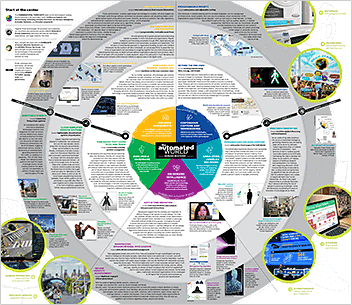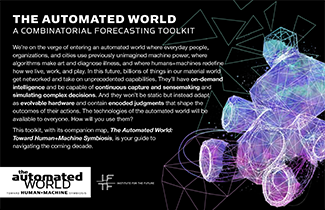Automated World Map + Toolkit

The Automated World: Toward Human + Machine Symbiosis
Since humans first began creating machines, we have shaped them and they have shaped us.
We created clocks to help us orchestrate and coordinate tasks and, in turn, clocks began to govern our lives. We created cars and then cars turned us into motorists, auto mechanics, and commuters. Over the centuries, we have populated our world with machines that help us do things we can’t or don’t want to do ourselves. From steam-powered mills to telephone switchboards to jet engines, our technologies have created new capabilities and conveniences and allowed us to automate and optimize many aspects of human activity.
 Over the past several decades, our world has become so saturated with machines that they have faded into the background. We hardly notice them. And we are reaching a new threshold—our machines are getting networked, connected, and in the process gaining capabilities once reserved for computers, enabling new forms of human+machine symbiosis.
Over the past several decades, our world has become so saturated with machines that they have faded into the background. We hardly notice them. And we are reaching a new threshold—our machines are getting networked, connected, and in the process gaining capabilities once reserved for computers, enabling new forms of human+machine symbiosis.
As cloud computing and intelligence becomes pervasive and available on-demand, machines will gain the ability to capture and make sense of data, effectively enabling them to see, hear, and quantify sensory information. They will be able to simulate outcomes to optimize planning, scheduling, and strategic decision-making. Products that were once considered finished upon shipping will be constantly upgraded and enhanced with software. And as the billions of machines that surround us become increasingly autonomous, we will be challenged to embed and encode our most complex ethical principles into the things that surround us. The ubiquity, connectivity, and intelligence of these machines will enable automation at an unprecedented scale.
 Moving toward human+machine symbiosis
Moving toward human+machine symbiosis
This map of the Automated World, coupled with a companion toolkit of foundational technologies, is your guide to navigate the coming decade.
This toolkit contains 3 suits of cards to help you create your own forecasts, explore the future at the intersections of foundational technologies and generate strategic insights. Follow the steps and begin prototyping the future you want today!
STEP 1: Build your own combinatorial forecasts. This suit of 18 cards describes the different Foundational Technologies that combine to make the automated world possible.
STEP 2: Chart Your Future Possibilities. This suit of 5 cards outlines the combinatorial forecasts that are the building blocks of the automated world. Use these cards to think through their impact and generate strategic insights.
STEP 3: Design Your Artifacts From the Future. This suit of 6 cards describes scenarios of products, services, and systems of the automated world. Use them to tell your own story of the automated world and design your own artifact from the future.
Publication Date
- Public Release: Fall 2016
- Member-only Release: Fall 2015
To learn more ...
- Learn about becoming a Future 50 Partner
- Contact Sean Ness | 650-233-9517 | sness@iftf.org




